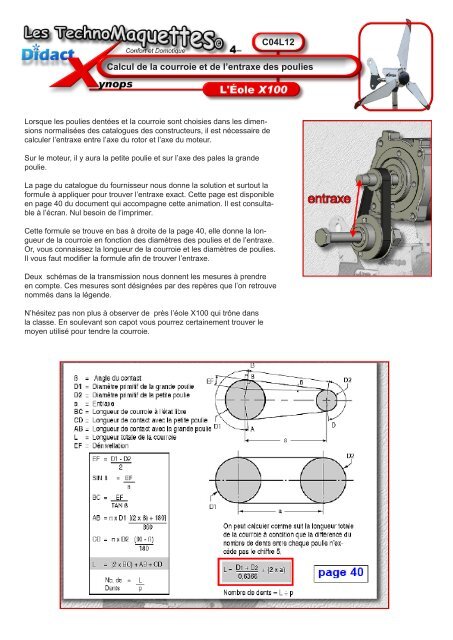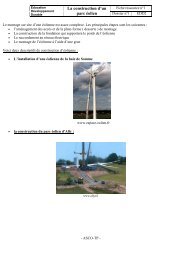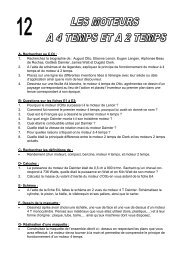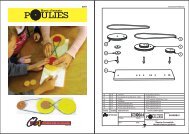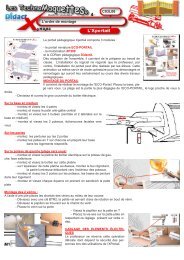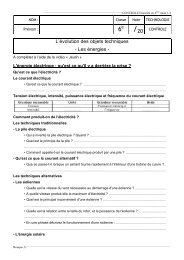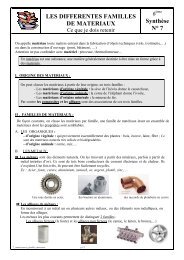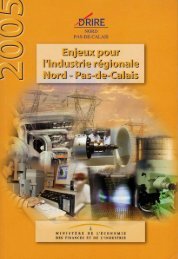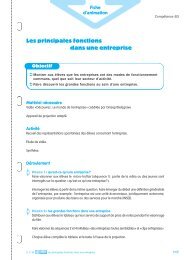Calcul de la courroie et de l'entraxe des poulies C04L12 - EuroTech
Calcul de la courroie et de l'entraxe des poulies C04L12 - EuroTech
Calcul de la courroie et de l'entraxe des poulies C04L12 - EuroTech
Create successful ePaper yourself
Turn your PDF publications into a flip-book with our unique Google optimized e-Paper software.
<strong>C04L12</strong><br />
<strong>Calcul</strong> <strong>de</strong> <strong>la</strong> <strong>courroie</strong> <strong>et</strong> <strong>de</strong> l’entraxe <strong>de</strong>s <strong>poulies</strong><br />
Lorsque les <strong>poulies</strong> <strong>de</strong>ntées <strong>et</strong> <strong>la</strong> <strong>courroie</strong> sont choisies dans les dimensions<br />
normalisées <strong>de</strong>s catalogues <strong>de</strong>s constructeurs, il est nécessaire <strong>de</strong><br />
calculer l’entraxe entre l’axe du rotor <strong>et</strong> l’axe du moteur.<br />
Sur le moteur, il y aura <strong>la</strong> p<strong>et</strong>ite poulie <strong>et</strong> sur l’axe <strong>de</strong>s pales <strong>la</strong> gran<strong>de</strong><br />
poulie.<br />
La page du catalogue du fournisseur nous donne <strong>la</strong> solution <strong>et</strong> surtout <strong>la</strong><br />
formule à appliquer pour trouver l’entraxe exact. C<strong>et</strong>te page est disponible<br />
en page 40 du document qui accompagne c<strong>et</strong>te animation. Il est consultable<br />
à l’écran. Nul besoin <strong>de</strong> l’imprimer.<br />
C<strong>et</strong>te formule se trouve en bas à droite <strong>de</strong> <strong>la</strong> page 40, elle donne <strong>la</strong> longueur<br />
<strong>de</strong> <strong>la</strong> <strong>courroie</strong> en fonction <strong>de</strong>s diamètres <strong>de</strong>s <strong>poulies</strong> <strong>et</strong> <strong>de</strong> l’entraxe.<br />
Or, vous connaissez <strong>la</strong> longueur <strong>de</strong> <strong>la</strong> <strong>courroie</strong> <strong>et</strong> les diamètres <strong>de</strong> <strong>poulies</strong>.<br />
Il vous faut modifier <strong>la</strong> formule afin <strong>de</strong> trouver l’entraxe.<br />
Deux schémas <strong>de</strong> <strong>la</strong> transmission nous donnent les mesures à prendre<br />
en compte. Ces mesures sont désignées par <strong>de</strong>s repères que l’on r<strong>et</strong>rouve<br />
nommés dans <strong>la</strong> légen<strong>de</strong>.<br />
N’hésitez pas non plus à observer <strong>de</strong> près l’éole X100 qui trône dans<br />
<strong>la</strong> c<strong>la</strong>sse. En soulevant son capot vous pourrez certainement trouver le<br />
moyen utilisé pour tendre <strong>la</strong> <strong>courroie</strong>.
Poulies <strong>et</strong> <strong>courroie</strong>s <strong>de</strong> positionnement<br />
LONGUEUR DES COURROIES CRANTEES<br />
Les <strong>courroie</strong>s sont à longueur fixe. Par conséquent, prévoir un système pour régler<br />
l’entraxe <strong>et</strong> tendre <strong>la</strong> chaîne ou <strong>la</strong> <strong>courroie</strong>: voir les bras ten<strong>de</strong>urs TRE, TPX, MIX,<br />
AH, <strong>et</strong> les gal<strong>et</strong>s ten<strong>de</strong>urs RE ou XRP.<br />
Contactez-nous pour dimensionner vos systèmes.<br />
ß = Angle du contact<br />
EF<br />
D1 = Diamètre primitif <strong>de</strong> <strong>la</strong> gran<strong>de</strong> poulie<br />
D2 = Diamètre primitif <strong>de</strong> <strong>la</strong> p<strong>et</strong>ite poulie<br />
a = Entraxe<br />
BC = Longueur <strong>de</strong> <strong>courroie</strong> à l’état libre<br />
CD = Longueur <strong>de</strong> contact avec <strong>la</strong> p<strong>et</strong>ite poulie<br />
AB = Longueur <strong>de</strong> contact avec <strong>la</strong> gran<strong>de</strong> poulie D1<br />
L = Longueur totale <strong>de</strong> <strong>la</strong> <strong>courroie</strong><br />
EF = Dénivel<strong>la</strong>tion<br />
EF = D1 - D2<br />
2<br />
SIN ß = EF<br />
a<br />
BC = EF<br />
TAN ß<br />
AB = π x D1 [(2 x ß) + 180]<br />
360<br />
CD = π x D2 (90 - ß)<br />
180<br />
L<br />
= (2 x BC) + AB + CD<br />
Nb. <strong>de</strong> = L<br />
Dents p<br />
D1<br />
B<br />
ß<br />
A<br />
On peut calculer comme suit <strong>la</strong> longueur totale<br />
<strong>de</strong> <strong>la</strong> <strong>courroie</strong> à condition que <strong>la</strong> différence du<br />
nombre <strong>de</strong> <strong>de</strong>nts entre chaque poulie n’excè<strong>de</strong><br />
pas le chiffre 5.<br />
L= D1 + D2 + (2 x a)<br />
0,6366<br />
Nombre <strong>de</strong> <strong>de</strong>nts = L ÷ p<br />
a<br />
a<br />
ß<br />
D<br />
D2<br />
D2<br />
➍40<br />
Tome 4 2006<br />
HPC<br />
www.hpceurope.com


